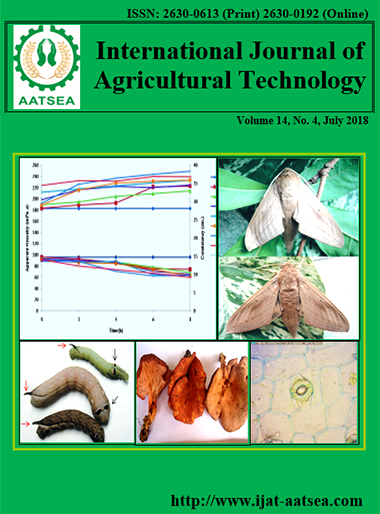Impact of Certain Egyptian Wax Foundation Types and Their Chemical Composition on Biological Activities of Honey Bees
Main Article Content
Abstract
The quality of certain beeswax foundation sheets locally marketed that named by Etman, Mady and Nasr and natural beeswax secretion by bees was determined. Quality was evaluated which based on the effect of beeswax foundation sheets on the biological activities of honey bee colonies. Also, the chemical analysis of these natural beeswax or foundation sheets was detected by Gas Chromatography (GC) and Mass Spectrometry (MS).Those parameters were carried out all through unique blooming seasons of citrus, clover and black cumin in three governorates of Egypt. In April season the studies showed significant differences in the average area of comb built (drawn) by honey bee colonies after one month in Qalubia region. Also, at the same region a significant area of wax cells built were used for worker brood in Mady beeswax foundation followed by Etman and Nasr beeswax foundation. Mady wax foundation had a significant area of honey stored at Qalubia region. Tested colonies at Beni Sauef built a highly area of wax cells (243.3 inch²) of Etman wax foundation followed by Assiut (203.3 inch²) and Qalubia region (133.6 inch²). In June period Beni Sauef recorded a significant value of natural secreted wax cells (373.33 inch²) followed by of Assiut (350 inch²) and Qalubia (221.66 inch²) after one month of test technique. It is noticed that the natural secreted wax cells were used for worker brood rearing at Qalubia region. Results indicated that during June period bee workers in the tested colonies used natural secreted wax cells for honey stored and drone brood rearing at Beni Sauef and Assiut regions.
Article Details

This work is licensed under a Creative Commons Attribution-NonCommercial-NoDerivatives 4.0 International License.
References
Aichholz, R. and Lorbeer, E. (2000). Investigation of combwax of honeybees with high-temperature gas chromatography and high–temperature gas chromatography–chemical ionization mass spectrometry. II – High-temperature gas chromatography-chemical ionization mass spectrometry. Journal of Chromatography A 883:75-88.
Bernal, J. L., Jiménez, J. J., del Nozal, M. J., Toribio, L. and Martín, M. T. (2005). Physico-chemical parameters for the characterization of pure beeswax and detection of adulterations. European Journal of Lipid Science and Technology 107:158-166.
Brand-Garnys, E. E. and Sprenger, J. (1988). Bienenwachs – Neue Aspekte eines klassischen Kosmetic – Rohstoffes. Z. Körperpflegemittel-, Parfümerie-, Riechstoff- und Aerosol – Industrie 61:547-552.
Fresnay, J. (1962). A new instrument for brood measurement in a honey bee colony. The American Bee Journal 111:20-21.
Jimenez, J. J., Bernal, J. L., Aumente, S., del Nozal, M. J., Martin, M. T. and Bernal, Jr. J. (2004). Quality assurance of commercial beeswax – Part I. Gas chromatography – electron impact ionization mass spectrometry of hydrocarbons and monoesters. Journal of Chromatography A 1024:147-154.
Maia, M. and Nunes, F. M. (2013). Authentication of beeswax (Apis mellifera) by high-temperature gas chromatography and chemometric analysis. Food Chemistry 136: 961-968.
Namdar, D., Neuman, R., Sladezki, Y., Haddad, N. and Weiner, S. (2007). Alkane composition variations between darker and lighter colored comb beeswax. Apidologie 38:453-461.
Serra Bonvehi, J. and Ornantes Bermejo, F. J. (2012). Detection of adulterated commercial Spanish beeswax. Food Chemistry 132:642-648.
Serra, J., Cañas, S. and Gómez, A. (1989). Características físico-químicas de la cera de abejas producida en España. Alimentación, equipos y tecnología 5-6:213-216.
Skowronek, W. (1973). Rozwój gruczołów woskowych uróżnych ras pszczoły miodnej. Pszczelnicze Zeszyty Naukowe 17:1-9.
Streibl, M., Stransky, K. and Sorm, F. (1966). Über einige neue Kohlenwasserstoffe in Wachs der Honigbiene (Apis mellifera L.). Fette, Seifen, Anstrichmittel 68:799-805.
Tulloch, A. P. (1980) Beeswax – composition and analysis. Bee World 61:47-62.
Tulloch, A. P. and Hoffman, L. L. (1972). Canadian beeswax: Analytical values and composition of hydrocarbons, free acids and long chain esters. Journal of the American Oil Chemists' Society 49:696-699.
Tulloch, A. P. (1980). Beeswax – Composition and analysis. Bee World 61:47-62.
Vit, P., Roldán, S., Tamer, E., Olivo de Acosta, E. and Bianchi, M. (1992). Detección de adulteraciones en cera de abejas comercializadas en Venezuela. Revista del Instituto Nacional de Higiene Rafael Rangel 23:23-27.
Waś E., Szczęsna T., and Rybak-Chmielewska H. (2014b). Hydrocarbon composition of beeswax (Apis mellifera) collected from light and dark coloured combs. Journal of Apicultural Science 58:99-106.
Waś, E., Szczęsna, T. and Rybak-Chmielewska, H. (2014a). Determination of beeswax hydrocarbons by gas chromatography with a mass detector (GC-MS) technique, Journal of Apicultural Science 58:145-157.


